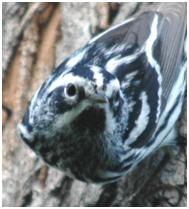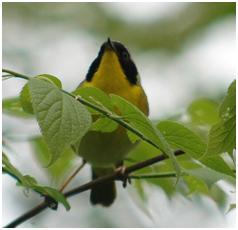My husband and I are coffee drinkers. In fact, recently I made the mistake of taking him along to help get a replacement when our old cappuccino machine died. We wound up with a machine so complicated I needed an advanced degree to make it work. But I digress. The reason for my writing about coffee at all is that for many years I have been looking to find coffee which is bird friendly, which means it is grown in the shade. Why is growing coffee in the shade important you might ask? Much of the coffee we buy is grown in neo-tropical countries where birds we see in the spring and summer spend their  winters. So when that yellow warbler leaves your backyard and heads to Central America, he starts his journey with the full intention of having a place to stay and food to eat when he arrives in his winter home. Since it is cheaper and easier to grow coffee by clear cutting the land of all trees and shrubs, this kind of agriculture is a very bad thing for the birds which migrate to these areas as well as the other wildlife which live there. Exhausted after a grueling trip south, battling hurricanes and all kinds of challenges, increasingly more often, migratory songbirds are reaching their traditional overwintering grounds and finding they have been clear cut or destroyed. Coffee is naturally a shade loving plant, but since it is cheaper to clear cut the growing area and then just treat the coffee plants with chemicals to keep them going, this has become the new norm for larger agricultural enterprises. So, if we want to help migratory birds (and other animals, too) keep their populations up by retaining their habitat intact and chemical free, buying shade grown coffee which is grown on plantations which retain the trees and undergrowth necessary for songbirds is an easy and practical solution.
winters. So when that yellow warbler leaves your backyard and heads to Central America, he starts his journey with the full intention of having a place to stay and food to eat when he arrives in his winter home. Since it is cheaper and easier to grow coffee by clear cutting the land of all trees and shrubs, this kind of agriculture is a very bad thing for the birds which migrate to these areas as well as the other wildlife which live there. Exhausted after a grueling trip south, battling hurricanes and all kinds of challenges, increasingly more often, migratory songbirds are reaching their traditional overwintering grounds and finding they have been clear cut or destroyed. Coffee is naturally a shade loving plant, but since it is cheaper to clear cut the growing area and then just treat the coffee plants with chemicals to keep them going, this has become the new norm for larger agricultural enterprises. So, if we want to help migratory birds (and other animals, too) keep their populations up by retaining their habitat intact and chemical free, buying shade grown coffee which is grown on plantations which retain the trees and undergrowth necessary for songbirds is an easy and practical solution.
Or so I thought. Coffee has many descriptive terms. It can be fair trade (which guarantees poor farmers in co-operatives a fair price for their coffee), organic (which refers to the use or non-use of chemicals), and (among other descriptive terms) shade grown. What I have come to discover is that shade grown can mean many things and these various terms are often mutually exclusive. So that if it is fair trade and/or organic, it may not be shade grown. And there is shade grown and then there is bird friendly shade grown. Until recently, even finding shade grown coffee was a challenge. You had to trust that the distributor really did buy coffee grown in the shade, if the shop even had any idea what you were talking about. I  thought I had found a great shade grown coffee, and have been using it for a very long time, only to discover that it most probably is shade grown but not bird friendly.
thought I had found a great shade grown coffee, and have been using it for a very long time, only to discover that it most probably is shade grown but not bird friendly.
I learned all this from Scott Weidensaul who really opened my eyes to what to look for. He told me that normal shade grown means they did not clear cut the trees. However, they do clear the undergrowth and so it causes a mono-culture of trees and coffee bushes. This is only mildly better than coffee grown in clear cut areas. Bird friendly coffee growers not only retain the tree canopy, they also keep the undergrowth which the birds need for food and shelter. Smithsonian has the only 100% organic bird-friendly coffee certification and their certifications are given only to growers who comply with a fairly rigid list of standards. The coffee is better tasting, too as it has no chemicals and ripens more slowly. You can buy Smithsonian bird friendly certified coffee at Birds And Beans which was founded by a group of concerned naturalists and birders including Kenn Kauffman. So, spread the word that buying bird friendly certified coffee is an easy way to help migrating birds as well as wildlife. Whenever biodiversity can be left intact, we all benefit from it.
So, now in my new complicated coffee machine, I have the real deal being brewed. Real bird friendly shade grown Smithsonian certified coffee. It makes a better cup of coffee if for no other reason than it really is an easy change to make in my routine and has such a wide-ranging benefit to so many birds and animals. Now that’s the best way to start the day!
Oh, and in case you thought that it was just the warblers who are affected by loss of habitat through coffee growing, think again. Here is a list of some of the species who return to or migrate through shade grown coffee plantations and who benefit from us taking a moment to think before we buy coffee:
Sharp-shinned Hawk
Broad-winged Hawk
American Kestrel
Lesser Nighthawk
Ruby-throated Hummingbird
Yellow-bellied Flycatcher
Traill’s (Willow and Alder) Flycatcher
Least Flycatcher
Hammond’s Flycatcher
Brown-crested Flycatcher
Sulphur-bellied Flycatcher
Western Kingbird
Yellow-throated Vireo
Blue-headed Vireo
Warbling Vireo
Red-eyed Vireo
Yellow-green Vireo
Violet-green Swallow
Cliff Swallow
Barn Swallow
Blue-gray Gnatcatcher
Swainson’s Thrush
Wood Thrush
Golden-winged Warbler
Tennessee Warbler
Nashville Warbler
Northern Parula
Yellow Warbler
Magnolia Warbler
Golden-cheeked Warbler
Black-throated Green Warbler
Townsend’s Warbler
Blackburnian Warbler
Black-and-white Warbler
American Redstart
Worm-eating Warbler
Ovenbird
Louisiana Waterthrush
Kentucky Warbler
Mourning Warbler
MacGillivray’s Warbler
Hooded Warbler
Wilson’s Warbler
Canada Warbler
Yellow-breasted Chat
Summer Tanager
Western Tanager
Rose-breasted Grosbeak
Indigo Bunting
Painted Bunting
Orchard Oriole
Baltimore Oriole
Bird species list provided by Dr. Oliver Komar, SalvaNATURA.